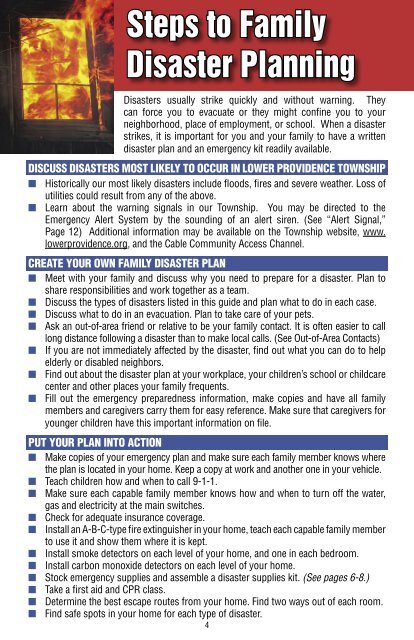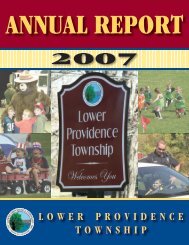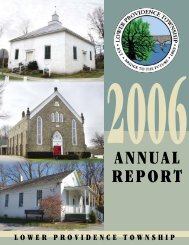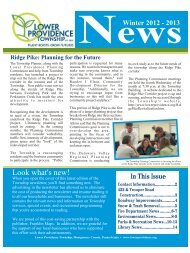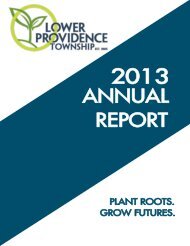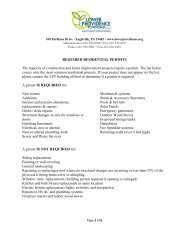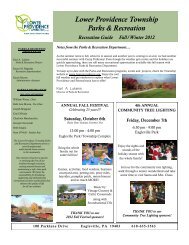Lower Providence Township Emergency Preparedness Guide
Lower Providence Township Emergency Preparedness Guide
Lower Providence Township Emergency Preparedness Guide
You also want an ePaper? Increase the reach of your titles
YUMPU automatically turns print PDFs into web optimized ePapers that Google loves.
Steps to FamilyDisaster PlanningDisasters usually strike quickly and without warning. Theycan force you to evacuate or they might confine you to yourneighborhood, place of employment, or school. When a disasterstrikes, it is important for you and your family to have a writtendisaster plan and an emergency kit readily available.DISCUSS DISASTERS MOST LIKELY TO OCCUR IN LOWER PROVIDENCE TOWNSHIP■ Historically our most likely disasters include floods, fires and severe weather. Loss ofutilities could result from any of the above.■ Learn about the warning signals in our <strong>Township</strong>. You may be directed to the<strong>Emergency</strong> Alert System by the sounding of an alert siren. (See “Alert Signal,”Page 12) Additional information may be available on the <strong>Township</strong> website, www.lowerprovidence.org, and the Cable Community Access Channel.CREATE YOUR OWN FAMILY DISASTER PLAN■ Meet with your family and discuss why you need to prepare for a disaster. Plan toshare responsibilities and work together as a team.■ Discuss the types of disasters listed in this guide and plan what to do in each case.■ Discuss what to do in an evacuation. Plan to take care of your pets.■ Ask an out-of-area friend or relative to be your family contact. It is often easier to calllong distance following a disaster than to make local calls. (See Out-of-Area Contacts)■ If you are not immediately affected by the disaster, find out what you can do to helpelderly or disabled neighbors.■ Find out about the disaster plan at your workplace, your children’s school or childcarecenter and other places your family frequents.■ Fill out the emergency preparedness information, make copies and have all familymembers and caregivers carry them for easy reference. Make sure that caregivers foryounger children have this important information on file.PUT YOUR PLAN INTO ACTION■ Make copies of your emergency plan and make sure each family member knows wherethe plan is located in your home. Keep a copy at work and another one in your vehicle.■ Teach children how and when to call 9-1-1.■ Make sure each capable family member knows how and when to turn off the water,gas and electricity at the main switches.■ Check for adequate insurance coverage.■ Install an A-B-C-type fire extinguisher in your home, teach each capable family memberto use it and show them where it is kept.■ Install smoke detectors on each level of your home, and one in each bedroom.■ Install carbon monoxide detectors on each level of your home.■ Stock emergency supplies and assemble a disaster supplies kit. (See pages 6-8.)■ Take a first aid and CPR class.■ Determine the best escape routes from your home. Find two ways out of each room.■ Find safe spots in your home for each type of disaster.4


